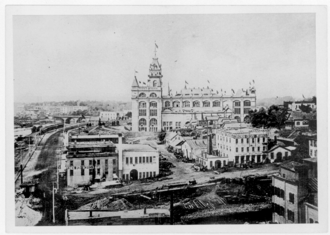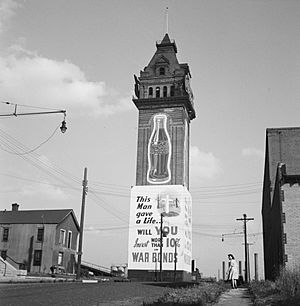Industrial Exposition Building facts for kids
Quick facts for kids Industrial Exposition Building |
|
|---|---|

The Industrial Exposition Building as seen from the Pillsbury 'A' Mill, c. 1890
|
|
| Alternative names | International Stock Food Company Warehouse |
| General information | |
| Status | Demolished |
| Location | 101 Central Avenue Southeast, Minneapolis, Minnesota |
| Coordinates | 44°59′9″N 93°15′24″W / 44.98583°N 93.25667°W |
| Completed | 1886 |
| Destroyed | 1940 |
| Height | |
| Roof | 240 ft (73 m) |
| Technical details | |
| Floor count | 8 |
The Industrial Exposition Building was a very important building in Minneapolis, Minnesota. It stood tall from 1886 until 1940. For a short time, it was even the tallest building in Minneapolis!
This building was used for many different events. It hosted local shows and was also the place where the 1892 Republican National Convention happened. This was a big meeting where the Republican Party chose their candidate for president. It was the only major political convention held in Minnesota for a very long time, until 2008.
Why Was It Built?
The idea for a big fair in Minneapolis started in 1885. This was because the city of St. Paul had gotten the permanent spot for the Minnesota State Fair. Some important people in Minneapolis, like Alden Blethen who owned the Minneapolis Tribune newspaper, felt left out.
They decided to hold a meeting to see if people would support a yearly industrial fair in Minneapolis. This fair would show off new inventions and products. It was meant to compete with St. Paul's agricultural fair. Supporters worked hard to raise money in late 1885. They reached their goal of $250,000 by December 15.
Building It Fast
The building was constructed where an old hotel, the Winslow House, used to be. Today, this area is near Bank Street SE, Central Avenue SE, Main Street SE, and Ortman Street SE.
An architect named Isaac Hodgson designed the building. It had eight stories and looked like a modified Renaissance style building. A tall tower of 240 feet (about 73 meters) stood at one corner. The outside walls were made of strong stone, and the inside had metal supports. It was estimated that 11,000 to 15,000 people could fit inside!
What's amazing is how quickly it was built. The first stone was laid on April 29, 1886. The entire building was finished just over three months later, on August 3!
Grand Opening!
On August 23, 1886, there was a huge party to celebrate the opening of the new building and its first big fair. About 50,000 people came to the celebration. Much of downtown Minneapolis was part of the fun.
Important people like Senator Cushman K. Davis and Archbishop John Ireland gave speeches. The US President, Grover Cleveland, and his wife Frances could not be there. But they sent a telegram to say congratulations. In a cool moment, Mrs. Cleveland touched a special button in New York. This started all the machines inside the new building in Minneapolis!
What Happened Next?
The first fair lasted 40 days and was a big hit. Nearly 500,000 people visited! They saw the newest technology and industrial inventions. There was also a large collection of art and sculptures.
However, in the years that followed, fewer people came. The fair started to lose money. Even though the building hosted the 1892 Republican National Convention, it wasn't enough to save the fair. By 1893, there were almost no exhibitors left, and the fair stopped completely.
Its Final Years
In 1896, a man named Thomas B. Janney bought the building for only $25,000. This was much less than it cost to build! For the next seven years, the building was sometimes used for performances.
- It hosted the first concerts of the Minneapolis Symphony Orchestra, which is now called the Minnesota Orchestra.
- Famous musicians like Johann Strauss II performed there.
- The New York Metropolitan Opera also put on shows.
In 1903, Marion Savage bought the building. He owned a famous racehorse named Dan Patch. Savage turned the building into the International Stock Food Company.
By the 1930s, the building was used as a large warehouse for the M.W. Savage Co. mail order company. Finally, in 1940, the building was torn down. A Coca-Cola bottling plant was built in its place. That bottling plant was also torn down in the 1980s. Today, the area has new apartment buildings.
 This article incorporates text from MNopedia, which is licensed under the Creative Commons Attribution-ShareAlike 3.0 Unported License.
This article incorporates text from MNopedia, which is licensed under the Creative Commons Attribution-ShareAlike 3.0 Unported License.


